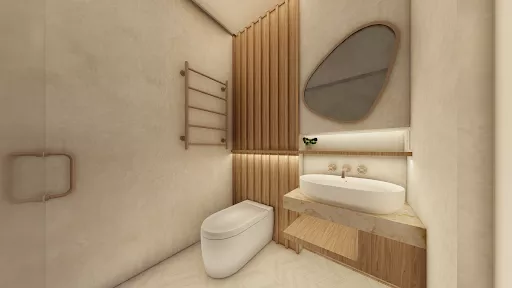What You Need to Know About Bathroom Ventilation

Modern bathroom exhaust fan installation with proper ventilation system
Proper bathroom ventilation is essential for maintaining a healthy, comfortable, and structurally sound home. Beyond preventing foggy mirrors, effective ventilation systems remove excess moisture that can lead to mold growth, paint peeling, and even structural damage. At CooperBuild, we prioritize proper ventilation in all our bathroom projects to ensure longevity and optimal indoor air quality.
Key Considerations for Bathroom Ventilation
1. Building Code Requirements
Most building codes, including those in New York City, mandate bathroom ventilation in the form of either an operable window or an exhaust fan. While windows provide natural ventilation, they're often insufficient on their own, especially in smaller bathrooms or during extreme weather conditions.
2. Exhaust Fan Placement
Proper installation is crucial for optimal performance. Bathroom exhaust fans should be placed near the shower or bathtub area to capture moisture at its source. Additionally, ensuring a sealed ductwork system prevents moisture from being redirected into ceiling or wall cavities, where it can cause damage.
3. Noise Levels
Fan noise is measured in sones—the lower the sone rating, the quieter the fan. For a peaceful bathroom environment, look for fans with ratings of 1.5 sones or less. Premium models can operate as quietly as 0.3 sones.
4. Energy Efficiency
ENERGY STAR-certified bathroom fans use approximately 60% less energy than standard models. Many modern fans include features like humidity sensors, which automatically activate when moisture levels rise, and timers that ensure the fan runs long enough to clear moisture after showering.
5. Installation Requirements
Professional installation ensures your ventilation system operates effectively. The fan should vent to the outside of your home—never into an attic, crawl space, or between walls, as this can lead to moisture problems in those areas.
Calculating the Required Exhaust Fan Size
At CooperBuild, we've collaborated with various HVAC subcontractors, including Metro Air and Superior HVAC. Through these partnerships, we've gathered valuable data highlighting the importance of determining the correct fan size. A fan that's too small won't effectively remove moisture and odors, while an oversized one may create unnecessary noise.
When sizing a vent fan for your bathroom, consider these factors:
1. Square Footage
Bathroom size directly impacts the needed fan capacity. Measure your bathroom's square footage to find the right fan size:
- For bathrooms under 50 square feet, a fan with a CFM (Cubic Feet per Minute) rating of 50-80 is suitable
- Bathrooms between 50 and 100 square feet require a fan with a CFM rating of 80-150
- Larger bathrooms, exceeding 100 square feet, may need fans with CFM ratings above 150
2. Bathroom Type
The type of bathroom also affects fan selection:
a. Half Bathrooms
Half bathrooms without a shower or bathtub have lower moisture levels. A fan with a CFM rating between 50-80 typically suffices to remove odors and maintain air quality.
b. Full Bathrooms
Full bathrooms with a shower or bathtub require higher CFM ratings due to increased moisture levels. Choose a fan with a CFM rating between 80-150 for effective moisture removal.
c. Master Bathrooms
Master bathrooms are often larger and equipped with luxury fixtures. They need exhaust fans with CFM ratings exceeding 150 to maintain optimal humidity levels and air quality.
d. Windowless Bathrooms
For windowless bathrooms, proper ventilation is even more critical. The minimum CFM rating should be 50-80 for small to medium-sized windowless bathrooms, with larger spaces requiring 80-150 CFM or more to ensure adequate ventilation.
3. Ductwork and Ventilation System
The efficiency of your bathroom exhaust fan also depends on the ductwork and ventilation system:
- Use a 4-inch or 6-inch round duct, as appropriate, for efficient airflow
- Minimize bends and obstructions in the ductwork to prevent airflow restrictions
- Consider using insulated ducts to prevent condensation and mold growth
Solutions for Limited Outdoor Access
When direct outdoor venting is challenging, consider these alternatives:
1. Ceiling Vent Installation
Installing a ceiling vent can efficiently ventilate a small bathroom with no outside access. This device allows moisture to escape, effectively preventing humidity buildup.
2. Floor Duct Vent
In cases where ceiling venting is impractical, floor duct vents offer an alternative solution. These devices use floor grates to remove moisture and odors, providing an additional exit point.
3. Remote Fan Systems
Remote fan systems place the motor away from the bathroom, typically in an attic or mechanical room, with only the grille visible in the bathroom ceiling. This arrangement reduces noise while still providing effective ventilation.
Professional Installation Matters
While DIY installation might seem appealing, professional installation ensures your ventilation system meets building codes and functions optimally. At CooperBuild, our experienced team ensures proper sizing, installation, and venting of bathroom exhaust systems to protect your investment and maintain a healthy indoor environment.
Proper bathroom ventilation is not just about comfort—it's an essential component of a well-built, healthy home that prevents costly damage and maintains air quality for years to come.
About Kristine Tronco
Kristine has extensive experience in technical support, estimation, and quantity surveying for both local and international construction projects.
Senior Project Manager
Subscribe to Our Newsletter
Get the latest insights, trends, and news from the construction industry delivered straight to your inbox.
We respect your privacy. Unsubscribe at any time.

